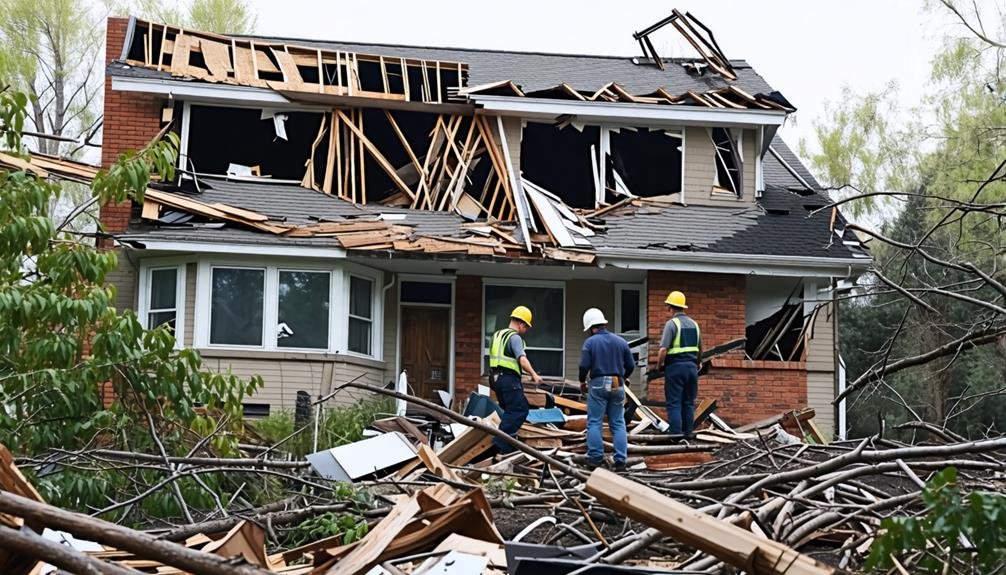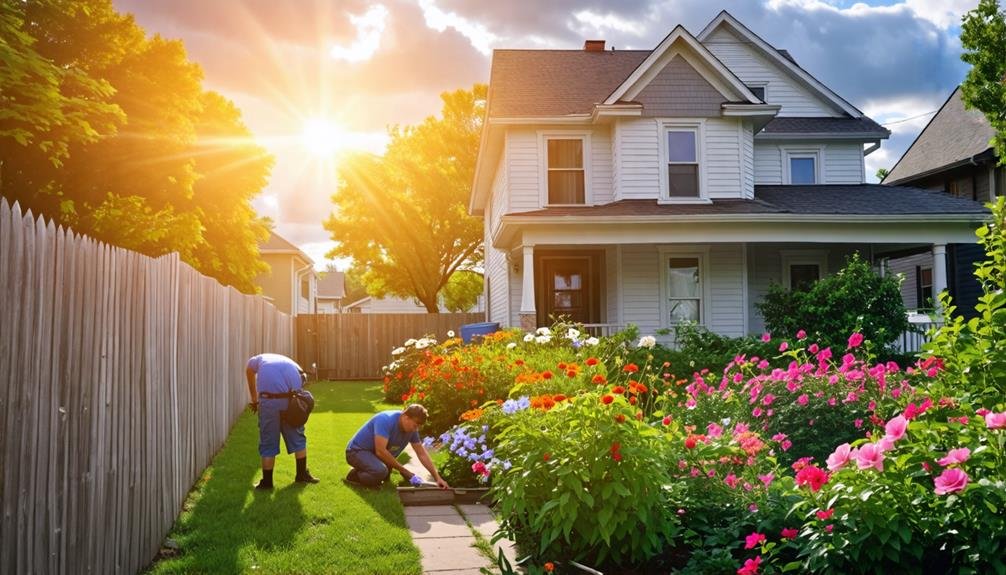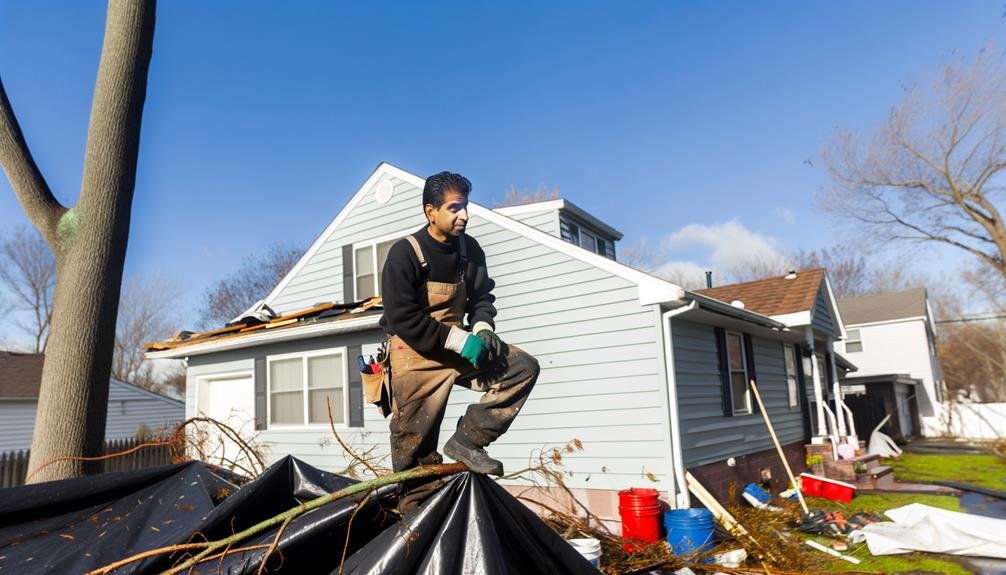After a storm hits Union City, it's essential to assess the damage promptly. Look for missing shingles, broken windows, and signs of water intrusion indoors. Prioritize repairs on leaks and structural issues to safeguard your home. Seek qualified professionals by checking their credentials and gathering recommendations. Document your findings to support any insurance claims, ensuring clear images and notes. Additionally, consider long-term restoration strategies, like regular inspections and proper drainage solutions, to prevent future problems. You'll find valuable insights on effective approaches and resources to help you restore your home with care during the upcoming sections.
Understanding Storm Damage

When severe weather strikes, do you know how to identify the signs of storm damage that could affect your property? Understanding different storm types is essential, as each can leave unique damage indicators. For instance, high winds from hurricanes or tornadoes can strip shingles off roofs, while heavy rainfall may lead to water pooling in your yard or even seepage into your basement.
Look for bent tree branches, which suggest strong gusts, or missing siding that could indicate hail damage. If you spot cracks in your foundation or walls, they might signal more serious underlying issues caused by shifting soil or flooding. Roof damage can be harder to detect, so inspect for missing or damaged tiles after a storm.
Always check your gutters, too; they can become clogged with debris, leading to water buildup. Recognizing these signs early helps you take action before smaller issues escalate into costly repairs. The freedom to enjoy your home comes with the responsibility of being vigilant about potential storm damage. By knowing what to look for, you can protect your property and maintain its integrity amidst nature's challenges.
Assessing the Impact
After identifying the signs of storm damage, it's vital to evaluate the overall impact on your property to determine the extent of repairs needed. Start with a thorough visual inspection, checking the exterior for missing shingles, cracked siding, or broken windows. Each of these issues contributes to the storm impact on your home, and identifying them early can save you from more extensive damage later.
Next, move indoors. Look for water stains, mold growth, or warped ceilings, as these indicate leaks that require immediate attention. Documenting these findings during your damage evaluation is fundamental; take photos and make notes to support any insurance claims.
Don't forget to examine your landscaping and fencing, as these elements can likewise suffer from severe weather. Evaluating the overall damage helps prioritize repairs, ensuring you address the most pressing issues first. Engaging with a professional can provide deeper insights into structural integrity and hidden damages. Remember, your home is your sanctuary, and understanding the full scope of the storm impact is the first step towards restoring it with care and precision.
Prioritizing Immediate Repairs

Identifying and addressing immediate repairs is vital to preventing further damage and guaranteeing your home remains safe and secure after a storm. Start by evaluating the most significant issues that could threaten your home's integrity. Prioritize repairs that address water intrusion, structural stability, and safety hazards.
Here's a quick guide to help you prioritize:
| Priority Level | Repair Type | Temporary Solutions |
|---|---|---|
| High | Roof leaks | Tarps or waterproof covers |
| High | Broken windows | Board up with plywood |
| Medium | Flooded areas | Sump pump or wet vac |
| Medium | Downed branches | Cut and remove debris |
| Low | Cosmetic damage | Paint touch-ups or repairs |
Incorporating emergency preparedness into your repair strategy not only protects your home but also guarantees peace of mind. Utilize temporary solutions where necessary to safeguard your property until more permanent fixes can be implemented. Remember, taking swift action is vital to maintaining your home's safety and preventing further complications.
Choosing Professional Services
Selecting the right professional services for storm damage repair is crucial to restoring your home efficiently and effectively. You'll want to focus on contractor selection that aligns with your specific needs. Start by seeking expert recommendations from friends, family, or online reviews. These insights can provide a clearer picture of the contractor's reliability and quality of work.
Once you've narrowed down your options, check their credentials. Confirm they're licensed, insured, and experienced in storm damage repairs. Don't hesitate to ask for references and previous project portfolios—this can reveal their expertise and craftsmanship.
When discussing your project, pay attention to the contractor's communication style. A professional should listen to your concerns, provide clear explanations, and outline a detailed plan. This transparency promotes trust, crucial for a collaborative relationship.
Always request a written estimate that breaks down costs and timelines. This helps prevent misunderstandings later. Choosing the right contractor can offer peace of mind, knowing your home is in capable hands. By investing time in contractor selection, you're not just fixing your home; you're guaranteeing a safe, secure environment for you and your loved ones.
Insurance Claims Process

Understanding your insurance policy is vital for maneuvering the claims process effectively. You'll need to document all damages thoroughly to support your claim and guarantee you receive the coverage you're entitled to. Let's investigate how to approach this process systematically to avoid potential pitfalls.
Understand Your Policy
When it comes to managing your insurance policy, knowing the specifics of your coverage can make a significant difference in the claims process after storm damage. Familiarizing yourself with your policy coverage and any claim exclusions helps you navigate this challenging time more effectively.
Here's a quick overview to assist you:
| Policy Coverage | Claim Exclusions |
|---|---|
| Dwelling protection | Flood damage |
| Personal property coverage | Earthquake damage |
| Additional living expenses | Negligence or lack of maintenance |
| Liability coverage | Intentional damage |
Understanding these key components can empower you to make knowledgeable choices. For instance, if flooding isn't covered, you might consider additional flood insurance. By knowing what's included and excluded in your policy, you can avoid unwelcome surprises during the claims process.
Take the time to review your policy documents and discuss any unclear terms with your insurance agent. This proactive approach not only helps you maintain your freedom during recovery but also guarantees you're prepared to restore your home effectively.
Documenting Damages Properly
Accurately documenting storm damage is crucial for ensuring your insurance claim is processed smoothly and fairly. To start, conduct a detailed damage assessment of your property. Take detailed notes on all affected areas, noting the type and extent of the damage. This information will be important for your claim.
Next, gather extensive repair documentation. Photos are your best friends here—snap clear images of the damage from multiple angles. Include timestamps if possible, as this strengthens your evidence. Furthermore, keep records of any temporary repairs you make to prevent further damage, like covering broken windows or patching leaks.
Compile all receipts for materials or services you've incurred during this process. These records not only support your claim but also show your proactive approach to safeguarding your home.
Preventative Measures
Taking proactive steps to secure your property can greatly reduce the risk of storm damage and the need for costly repairs later on. Implementing effective storm proofing techniques is essential to safeguarding your home. Start by inspecting your roof and ensuring shingles are secure. Replace any missing or damaged ones, as this simple home maintenance task can prevent leaks.
Next, consider reinforcing windows and doors with storm shutters or impact-resistant glass. This minimizes the risk of breakage during intense winds. Don't forget to clear gutters and downspouts, allowing for proper drainage and preventing water backup that can cause flooding.
Moreover, if you live in an area prone to flooding, it's wise to raise critical systems like your HVAC to higher ground. Landscaping is another key factor; strategically placed trees can act as windbreaks, while proper grading directs water away from your foundation.
Long-Term Restoration Tips

Restoring your home after storm damage requires a systematic approach to guarantee not only repairs but furthermore the long-term resilience of your property. To assure home safety and improve your recovery, consider the following tips:
- Regular Inspections: Conduct routine assessments of your roof, siding, and foundation. Early detection of issues can prevent extensive damage later.
- Invest in Quality Repairs: Use high-quality materials and hire reputable contractors. Cutting corners might save you money upfront, but it could cost you more in the long run.
- Improve Drainage Systems: Enhance your property's drainage systems to divert water away. Proper drainage is crucial in preventing future flooding and erosion.
- Engage with Community Support: Connect with local organizations for resources, advice, and assistance. Building a network can provide emotional support and practical help during your restoration journey.
Conclusion
In Union City, nearly 70% of homeowners face storm damage at some point, emphasizing the need for preparedness and swift action. By understanding the impact of storms and prioritizing repairs, you can restore your home effectively. Choosing professional services guarantees quality work, and maneuvering the insurance claims process with care can reduce stress. Remember, taking preventative measures now can save you time and money in the long run. Your home deserves the best care and restoration possible.

